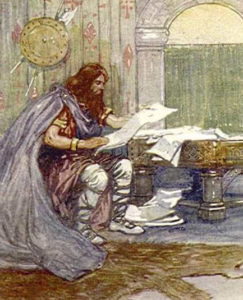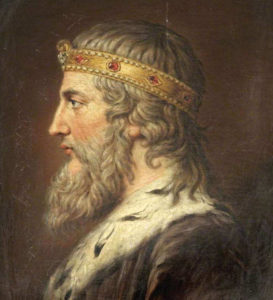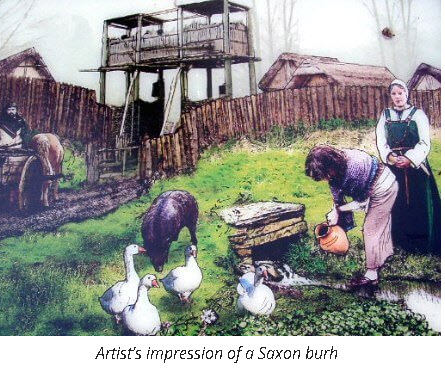Alfred “The Great,” King of England b 849
Alfred “The Great,” King of England was born in 849 in Wantage, Oxfordshire. He died on 26 Oct 901 in Winchester, Hampshire. He was buried in 901 in Winchester Cathedral, Winchester. Alfred married Ealhswith Mercia Gaimai. Queen Ealhswith was born in 852 in Mercia. She died on 5 Dec 905 in Winchester.
Alfred the Great was King of Wessex from 871 to 886 and King of the Anglo-Saxons from 886 to 899. He was the youngest son of King Æthelwulf of Wessex. His father died when he was young and three of Alfred’s brothers, Æthelbald, Æthelberht and Æthelred, reigned in turn. History does not mention Alfred during the reigns of his two oldest brothers, Æthelbald and Æthelberht. Alfred’s public life began in 865 at age 16 with the accession of his third brother, 18-year-old Æthelred
During his reign, he ruled successfully over his Anglo-Saxon kingdom and emerged as a military force, a strong leader and a promoter of reforms. His most important achievement was to prevent an island-wide invasion from the Danes and establish a united Anglo-Saxon culture.He was the first monarch from the British Isles to style himself as ‘King of the Anglo-Saxons’ and so he is sometimes considered the first English king
Details of his life are described in a work by 9th-century Welsh scholar and bishop Asser.
Children of King Alfred and Queen Ealhswith:
- Æthelflæd, Lady of the Mercians
- Edward the Elder
- Æthelgifu, abbess of Shaftesbury
- Ælfthryth, Countess of Flanders
- Æthelweard of Wessex
Since the late 8th century, the Vikings had primarily engaged in “hit-and-run” raids on centers of wealth such as monasteries. The Great Heathen Army was distinct from these raids in that it was much larger and formed to occupy and conquer large territories.
Alfred’s first major encounter was with the Great Heathen Army, which was a coalition of Norse warriors, originating in Denmark but including war bands from Norway and Sweden, who came together under a unified command to invade the four Anglo-Saxon kingdoms that constituted England in AD 865
The name Great Heathen Army is derived from the Anglo-Saxon Chronicle of 865. Legend has it that the force was led by five sons of Ragnar Lodbrok Sigurdsson, including, Halfdan Ragnarsson, Hvitserk, Ivar the Boneless, Bjorn Ironside and Ubba.The campaign of invasion and conquest against the Anglo-Saxon kingdoms lasted 14 years. Surviving sources give no firm indication of its numbers, but it was amongst the largest forces of its kind.
Over the years, Mercia collapsed, and the Army’s cohesion went with it. Halfdan went back to Northumbria and fought the Picts and the Strathclyde Welsh to secure his northern kingdom. His army settled there and he is not mentioned after 876, when “the Danes were engaged in sloughing and making a living for themselves.”
The Viking King Guthrum ruled the Danelaw (northern England) and parts of Mercia and Northumbria in the late-ninth century. He then set his sights on the Anglo-Saxon Kingdom of Wessex, ruled by Alfred the Great. Guthrum and his Vikings made a surprise attack on Alfred’s castle at Chippenham on Christmas, January 6, 878. Nearly taking Alfred captive.
Alfred spent the winter preceding the Battle of Edington in the Somerset marsh of Athelney, the nature of the country giving him some protection. In the spring of 878, he summoned his West Saxon forces and marched to Edington, where he met the Danes, led by Guthrum, in battle.
At the Battle of Edington, an army of the Anglo-Saxon kingdom of Wessex under Alfred the Great defeated the Great Heathen Army led by Guthrum on a date between 6 and 12 May AD 878, resulting in the Treaty of Wedmore later the same year
Three weeks after the battle, Guthrum was baptized at Aller in Somerset with Alfred as his sponsor. It is possible that the enforced conversion was an attempt by Alfred to lock Guthrum into a Christian code of ethics, hoping it would ensure the Danes’ compliance with any treaties agreed to. The converted Guthrum took the baptismal name of Athelstan.
Under the terms of the Treaty of Wedmore, the converted Guthrum was required to leave Wessex and return to East Anglia. Consequently, in 879 the Viking army left Chippenham and made its way to Cirencester and remained there for a year.The following year the army went to East Anglia, where it settled.
Also in 879, according to Asser, another Viking army sailed up the River Thames and wintered at Fulham. Over the next few years this particular Danish faction had several encounters with Alfred’s forces. However, Alfred managed to contain this threat by reforming his military and setting up a system of fortified cities, known as burghs or burhs.
At the centre of Alfred’s reformed military defense system was a network of burhs distributed at strategic points throughout the kingdom. There were thirty-three burhs, spaced approximately 30 kilometers (19 miles) apart, enabling the military to confront attacks anywhere in the kingdom within a day. burhs, later termed boroughs, were massive earthen walls surrounded by wide ditches reinforced with wooden revetments and palisades. The size of the burhs ranged in size from tiny outpost to large fortifications.
To maintain the burhs, and to reorganize the general militia as a standing army, Alfred expanded the tax and conscription system based on the productivity of a tenant’s landholding. The hide was the basic unit of the system on which the tenant’s public obligations were assessed. A hide is thought to represent the amount of land required to support one family. The hide would differ in size according to the value and resources of the land, and the landowner would have to provide service based on how many hides he owned.
Alfred also tried his hand at naval design. He ordered the construction of a small fleet, perhaps a dozen or so longships that, at 60 oars, were twice the size of Viking warships. Prior to Alfred, Wessex had possessed a royal fleet. King Athelstan of Kent and Ealdorman Ealhhere had defeated a Viking fleet in 851 capturing nine ships, and Alfred himself had conducted naval actions in 882.
Asser speaks grandiosely of Alfred’s relations with foreign powers but little definite information is available. His interest in foreign countries is shown by the insertions which he made in his translation of Orosius. He corresponded with Elias III, the Patriarch of Jerusalem, and embassies to Rome conveying the English alms to the Pope were fairly frequent. Around 890, Wulfstan of Hedeby undertook a journey from Hedeby on Jutland along the Baltic Sea to the Prussian trading town of Truso. Alfred personally collected details of this trip.
In the 880s, at the same time that he was working to convince his nobles to build and man the burhs, Alfred, perhaps inspired by the example of Charlemagne almost a century before, undertook an equally ambitious effort to revive learning. During this time period the Viking raids were often seen as a divine punishment and Alfred may have wished to revive religious awe in order to appease God’s wrath.
 This revival entailed the recruitment of clerical scholars from Mercia, Wales and abroad to enhance the tenor of the court and of the episcopacy; the establishment of a court school to educate his own children, the sons of his nobles, and intellectually promising boys of lesser birth; an attempt to require literacy in those who held offices of authority; a series of translations into the vernacular of Latin works the king deemed “most necessary for all men to know.’, the compilation of a chronicle detailing the rise of Alfred’s kingdom and house, with a genealogy that stretched back to Adam, thus giving the West Saxon kings a biblical ancestry.
This revival entailed the recruitment of clerical scholars from Mercia, Wales and abroad to enhance the tenor of the court and of the episcopacy; the establishment of a court school to educate his own children, the sons of his nobles, and intellectually promising boys of lesser birth; an attempt to require literacy in those who held offices of authority; a series of translations into the vernacular of Latin works the king deemed “most necessary for all men to know.’, the compilation of a chronicle detailing the rise of Alfred’s kingdom and house, with a genealogy that stretched back to Adam, thus giving the West Saxon kings a biblical ancestry.
Following the example of Charlemagne, Alfred established a court school for the education of his own children, those of the nobility, and “a good many of lesser birth.’ There they studied books in both English and Latin and “devoted themselves to writing,
Alfred’s educational ambitions seem to have extended beyond the establishment of a court school. Believing that without Christian wisdom there can be neither prosperity nor success in war, Alfred aimed “to set to learning all the free-born young men now in England who have the means to apply themselves to it” Conscious of the decay of Latin literacy in his realm Alfred proposed that primary education be taught in English, with those wishing to advance to holy orders to continue their studies in Latin.
Asser wrote of Alfred in his Life of King Alfred,
Now, he was greatly loved, more than all his brothers, by his father and mother—indeed, by everybody—with a universal and profound love, and he was always brought up in the royal court and nowhere else. … [He] was seen to be more comely in appearance than his other brothers, and more pleasing in manner, speech and behaviour … in spite of all the demands of the present life, it has been the desire for wisdom, more than anything else, together with the nobility of his birth, which have characterized the nature of his noble mind.
It is also written by Asser that Alfred did not learn to read until he was twelve years old or later, which is described as “shameful negligence” of his parents and tutors. Alfred was an excellent listener and had an incredible memory and he retained poetry and psalms very well. A story is told by Asser about how his mother held up a book of Saxon poetry to him and his brothers, and said; “I shall give this book to whichever one of you can learn it the fastest.” After excitedly asking, “Will you really give this book to the one of us who can understand it the soonest and recite it to you?” Alfred then took it to his teacher, learned it, and recited it back to his mother.
Alfred had a reputation as a learned and merciful man of a gracious and level-headed nature who encouraged education, proposing that primary education be conducted in English rather than Latin and improving the legal system, military structure and his people’s quality of life. He was given the epithet “the Great” during and after the Reformation in the sixteenth century.
Alfred died on 26 October 899 at the age of 50 or 51.How he died is unknown, although he suffered throughout his life with a painful and unpleasant illness. His biographer Asser gave a detailed description of Alfred’s symptoms and this has allowed modern doctors to provide a possible diagnosis. It is thought that he had either Crohn’s disease or hemorrhoids’. His grandson King Eadred seems to have suffered from a similar illness.
https://en.wikipedia.org/wiki/Alfred_the_Great
https://www.historic-uk.com/HistoryUK/HistoryofEngland/Alfred-the-Great/
Fun Story about King Alfred:
Relationship Report
for
John Edward BLACK
and
Alfred “The Great” King Of England b.849
——————————————————————————————
Alfred “The Great” King Of England is the 38th great-grandfather
of John Edward BLACK.
Lines of Descent from
Alfred “The Great” King Of England
—————————– / ———— \ —————————————
Alfred “The Great” King Of England b.849
Baldwin II OF FLANDERS b.865
Arnulf I Count of Flanders b.890
Baldwin III Count of Flanders b.940
Arnulf II Count of Flanders b.960
Baldwin IV Count of Flanders b.980
Baldwin V Count of Flanders b.1012
Robert Le Frison OF FLANDERS b.1032
Gertrude OF FLANDERS Duchess of Lorraine b.1070
Adélaide DE LEUVEN b.1090
Agatha Princess of LORRAINE b.1119
Beatrice I Countess of Burgundy b.1143
Duke Philipp VON HOHENSTAUFEN b.1177
Maria VON HOHENSTAUFFEN b.1201
Mathilde DE BRABANT Comtesse d’Artois b.1224
Blanche of Artois Queen of Navarre b.1248
Henry PLANTAGENET 3rd Earl Of Lancaster b.1281
Eleanor PLANTAGENET Countess of Arundel b.1318
Alice FITZALAN b.1352
Lady Eleanor de Holland b.1370
Joan CHERLETON b.1358
Arnold II ST. LEGER b.1378
John de SAINT LEGER , Sheriff Of Kent b.1399
Philippa de ST. LEGER b.1430
Reynold John DE PYMPE b.1448
Anne PYMPE b.1460
Elisabeth GUILDFORD b.1490
Elizabeth ISLEY b.1508
Henry HILL b.1530
Elizabeth HILL b.1560
Mary BUCKETT b.1602
John SOULE Sr. b.1632
John SOULE Jr. b.1675
Sarah SOULE b.1703
Samuel SNOW b.1729
Samuel SNOW Jr b.1752
Ebenezer SNOW b.1784
Bernard SNOW b.1822
Minnie SNOW b.1869
Mary Beatrice DASTRUP b.1902
John Edward BLACK

